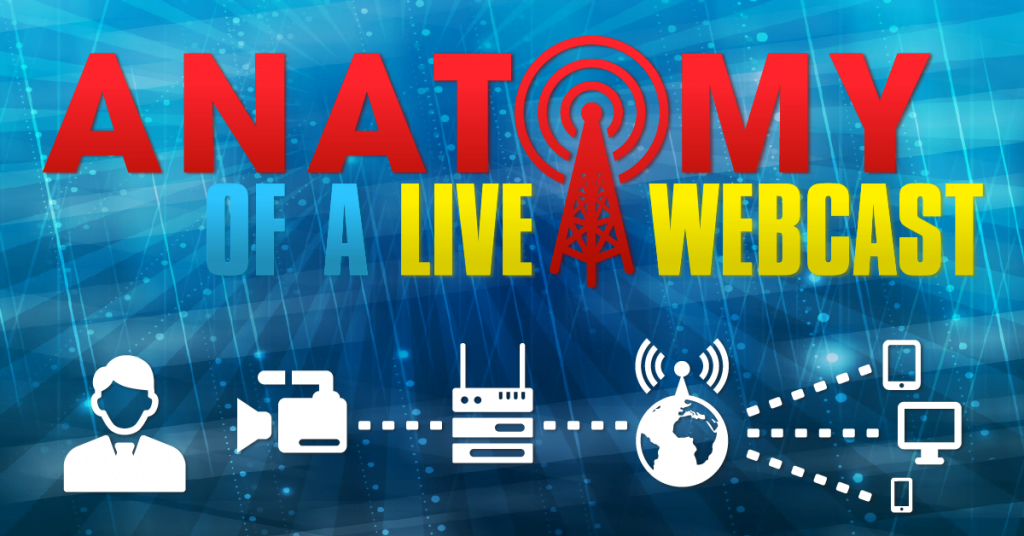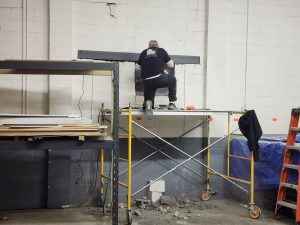A live webcast is essentially “broadcasting” video and audio over the Internet. Similar to a live broadcast on television, communication is typically one-way, and broadcasted live to dozens if not thousands of online viewers.
ANATOMY OF A LIVE WEBCAST
You have heard the expression – the only certainties in life are death and taxes? If you are a meeting and event planner you might want to add “webcasting” to that old and true adage.
Inevitably, if you are in the meetings and events industry, there will be a time in your not-so-distant-meeting-future, when a client will ask you something that might sound something like this: “Hey, we were discussing the possibility of making the meeting available to our satellite offices? Or, it might be phrased like this: “A lot of our sales reps work from home, and to save money, we were hoping to make this meeting available to them?” And without a doubt, this question will always be followed by the looming question: “How much would that cost?” Seem probable?
Obviously, like any good meeting and event planner, you realize that webcasting is not just a simple request. It’s not like changing the color of the drape or adding additional seating. No. It is much more than just another line item. Webcasting takes logistical planning and a basic technical knowledge of what is required. However, if you are a bit unsure of what is involved for webcasting, here are a few essential “need-to-knows” when a meeting turns into a “hybrid” conference or meeting.
So, when this happens, and it will — take a deep breath. After all, you are an event planner, and you have a roster of qualified suppliers eager to help you. However, before you do anything, you should first understand the difference between a “live webcast” and a “videoconference.”

Videoconference:
Similar to a webcast, a videoconference provides both audio and video. However, communication is “two-way” between two or more locations. All those participating in a videoconference can both hear and see each other. In other words, during a videoconference speakers/presenters present, while participants ask real-time questions using computer software and/or a conference phone line. One key distinction is to understand that the amount of live participants during a videoconference is very limited.
Furthermore, special software and hardware are required to fully participate during a videoconference. Although videoconferences are easy to set up, they are generally only useful for a small committee meeting and not capable of communicating with a large audience.

Live Webcast:
A live webcast is essentially “broadcasting” video and audio over the Internet. Similar to a live broadcast on television, communication is typically one-way, and broadcasted live to dozens if not thousands of online viewers. So for a large-scale meeting, where you will have a few hundred off-site viewers, webcasting is your only viable option.
A live webcast can be either private or public, but what is important to remember is that viewers typically only require an updated web browser and a computer capable of playing video and audio – special software or hardware is not typically required.
Webcasting Mindset:
So now that you can inform your client about the basic differences between webcasting and videoconferencing, what should your next move be after getting the go-ahead to begin the process of webcasting your meeting or event?
First and foremost, a webcast requires a marketing and promoting mindset. Just adding on the technical components to perform a webcast is a recipe for failure, because a webcast must be promoted, pushed, hyped and re-promoted again. Perhaps much of the reluctance with promoting a webcast is generational, but what is crucial for any planner is this – developing the right promotional/marketing mindset, when it comes to making your event a truly hybrid experience.
Accept it, believe in it and then promoted it.
Find the Right Supplier:
The next need-to-knows are more technical. They involve bandwidth, encoders and the ever ephemeral – content delivery network also known as the “cloud”. However, instead of troubling yourself with these technical issues, just ask your AV supplier what to do or who to call. Your AV company should have a viable webcasting option available or at the very least, they should be able to make a good recommendation. Just remember, a low-cost option is not your best approach. Think about all the planning involved and if you have gone to all the trouble and expense to make your event available via live webcasting – you will need a supplier that has both the skill and the experience to make your event a success.

Dedicated Bandwidth:
The next item is to find out about the venue’s Internet options. The proper bandwidth for the Internet connection is your lifeline to the “cloud” and a general rule of thumb is a 5mpg line (upload) is the minimum bandwidth for a robust streaming signal. Furthermore, the Internet line must be a “dedicated” connection and separated from either the hotel’s or the location’s Internet users. If other users are able to “leech off” the dedicated bandwidth — your live webcast could be compromised.

Adaptive Bit Rate Streaming:
Because so many people use mobile devices, it is vital that your webcast live stream be capable of an adaptive bit rate. An adaptive bit rate is a streaming technique used to detect the user’s bandwidth and helps adapt the multimedia signal to various CPU capacities. For example, if you are viewing on your mobile device or laptop, the ABR will allow for variations in bit rate and CPU capacity so that no matter what device your audience is viewing on, the video and the audio will adapt to help ensure constant live streaming. Video quality is often reduced, but an ABR will provide continuous streaming and convenience. Not adhering to an adaptive bit rate, will limit viewing options for your audience.

Live Video or Live Video with PowerPoint:
Most of the conventional webcasting services stream video and audio. This is typical for the majority of webcasting scenarios. However, if you require a more sophisticated solution, other webcasting options are available that will allow PowerPoint files to be simultaneously displayed in addition to the live video and audio stream. Most of the time, a webcast will only be a “switched” feed that combines live video/audio with switched graphic files via PowerPoint or Keynote. Keep in mind that if your clients are engineers or financial analyst, much of the detail contained on their slides will most likely appear blurry and unreadable when using a switched feed. On-line viewers could have have difficulty interpreting essential graphic details that require more clarity.

Social Media Options:
Integrating social media into a live meeting or presentation is a must. Social media allows online audience to more fully participate before during and after any event. From live Twitter feeds, to audience Q&A or streaming directly to a Facebook page, social media integration improves the audience’s experience for both the virtual and onsite attendees.
So without getting too technical and boring you with too much jargon, if you learn nothing else from this article, just remember that webcasting takes planning and the proper mindset. And remember that webcasting is just part of the evolutionary process for meetings and events. So holdfast, and embrace the live webcasting potential for your meetings and events – after all, webcasting is inevitable, just like the new adage says.




